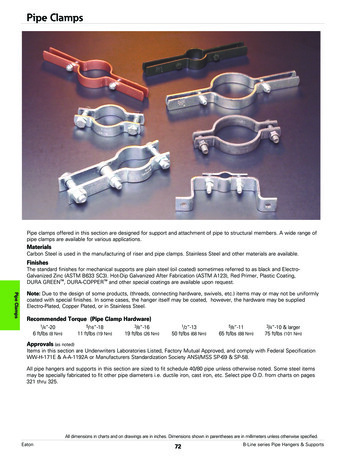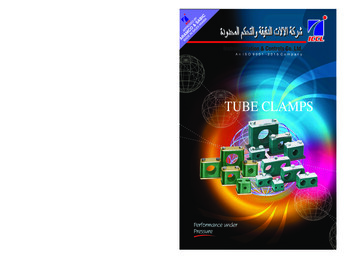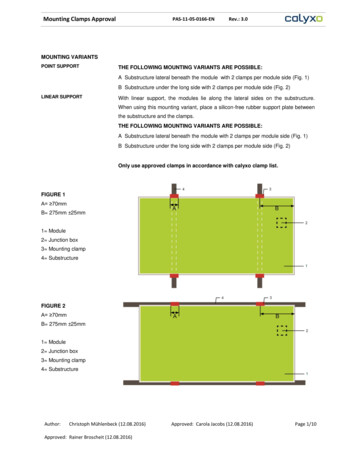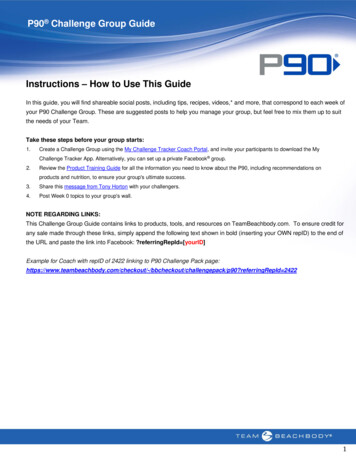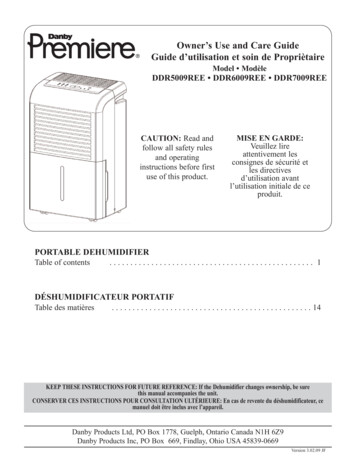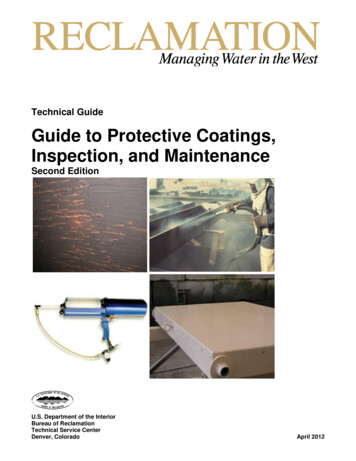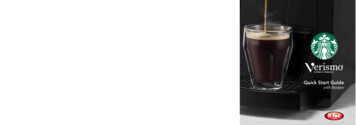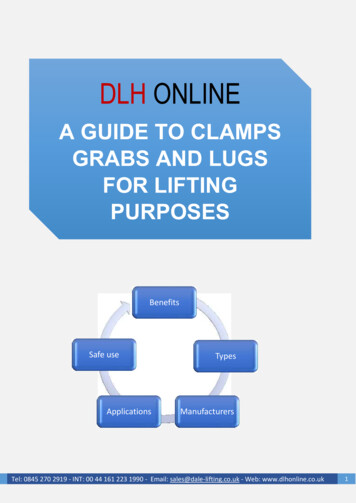
Transcription
DLH ONLINEA GUIDE TO CLAMPSGRABS AND LUGSFOR LIFTINGPURPOSESBenefitsSafe useApplicationsTypesManufacturersTel: 0845 270 2919 - INT: 00 44 161 223 1990 - Email: sales@dale-lifting.co.uk - Web: www.dlhonline.co.uk1
A Guide to Clamps, Grabs andLugs used for Lifting PurposesTable of ersStandardsInstructions for safe use and maintenanceContacting usPageNo./link3512131415Tel: 0845 270 2919 - INT: 00 44 161 223 1990 - Email: sales@dale-lifting.co.uk - Web: www.dlhonline.co.uk2
1. OverviewIn addition to various types of lifting slings which generally connect to the loadby hooking into lifting points or wrapping around the load, there are numerousclamps, grabs, scissor tongs or lifting lugs which can safely connect to the loadby gripping using friction or mechanical engagement with the load.Clamps are the ideal tool for handling loads safelyby overhead crane or hoist.Clamps like this steel plate clamp offer the abilityto lift, up-end, manoeuvre and position the loadin safety.Clamps can safely be used with a forklifttruck. Clamps can be attached using aforklift hook attachment or a fork jib,effectively turning your crane into a mobilecrane.This method of handling is much safer thanbalancing an unstable load over the forks and provides the ability to rotate andposition the load much more safely and precisely. (Continued)Tel: 0845 270 2919 - INT: 00 44 161 223 1990 - Email: sales@dale-lifting.co.uk - Web: www.dlhonline.co.uk3
Clamps and lugs can be used to lift a wide range of loads, including sheetmaterial such as steel, or even for more complex shapes such as various rolledsteel sections, there are purpose-made clampsfor pipes, cable drums, ISO Containers, steel,boards stone, steel and plastic drums orprefabricated concrete construction elements.The clamping force can be produced in a variety of ways. Thesimplest is by means of a screw thread.Some designs incorporate cams or scissormechanisms which utilise the weight of theload so that the gripping force produced is proportional tothe weight being lifted.Clamps can also be power operatedAs well as gripping the load to lift it,many clamps incorporate the facility totilt, rotate or orientate the load insome way.This is particularly useful for loadswhich need to be stored or transported in one plane butpresented for use in another.Tel: 0845 270 2919 - INT: 00 44 161 223 1990 - Email: sales@dale-lifting.co.uk - Web: www.dlhonline.co.uk4
2. Types of ClampsLet us now look at some of the more common types.Clamps for lifting sheet material are generally referred to as plate clamps andthere are two basic types: horizontal plate clamps and vertical plate clamps.Horizontal Plate ClampsAs the name implies, horizontal plateclamps only handle plate laid flat. Theyare therefore always used in pairs, oneeither side of the plate, in conjunctionwith a two leg sling.The clamps rely on either a lever or camto grip the plate and the angle of thesling leg must be such as to give thecorrect line of pull.Therefore the length of the sling legs mustbe matched to the width of the plate.Longer plates often need more than onepair of clamps to be adequately supportedin which case they are used in conjunctionwith a lifting beam.Variations of this type of clamp include designs forhandling single plates within a range of thickness, tobe adjustable to handle several ranges, or tohandle bundles of several plates.Tel: 0845 270 2919 - INT: 00 44 161 223 1990 - Email: sales@dale-lifting.co.uk - Web: www.dlhonline.co.uk5
Vertical Plate ClampsThe original designs of vertical plate clamps were intended only to lift plate inthe vertical plane or lay it down from the vertical in one direction only.Attempting to lower the plate in the opposite direction caused the mechanismto release the plate.They could not therefore be used to turn over plates in a single movement.Another limitation of early designs was that the weight of the lifting machinehook bearing down in the clamp lifting eye couldalso release the grip.Modern designs are rather more sophisticated andmuch safer. However they still have theirlimitations and it is essential to understand themand select the appropriate design for theparticular application.The simplest designs utilise ascrew thread which ismanually tightened to grip the load. They are particularlyuseful for applications where the clamp is to be left inplace between a series of handling operations.The majority of vertical plate clamps use a cam giving aclamping force which is proportional to the load.Generally the initial grip of cam types comes from a springoperated by a lever which the user flips over into thelocked position after positioning the clamp on the plate.Vertical plate clamps can only lift one plate at a time.Generally the line of pull should be square to the plateedge but most manufacturers also make a "universal"type which allows the line of pull to be at an angle to theedge.Tel: 0845 270 2919 - INT: 00 44 161 223 1990 - Email: sales@dale-lifting.co.uk - Web: www.dlhonline.co.uk6
Soft Jaw Plate ClampsClamps intended for lifting steel plate generally havesharp teeth which bite into the plate, giving a degree ofmechanical connection rather than relying just onfriction.However there are non-markingclamps designed to handle plates ofharder material or which havedelicate surfaces whereindentations from the clamp teethwould be unacceptable.Pile ClampsAnother variation of the vertical types are clampsdesigned to be released remotely, typically forapplications such as pile pitching.Container LiftingLugsLifting lugs for top orbottom side connectionto ISO containers.Tel: 0845 270 2919 - INT: 00 44 161 223 1990 - Email: sales@dale-lifting.co.uk - Web: www.dlhonline.co.uk7
Steel Section Clamps and GrabsOther steel sections such astubes, angles, channels,universal beams and railwaylines can all be liftedby standard clamps designedfor the particular section.Girder ClampsGirder clamps which locate onto the flange of abeam are available either as a suspension pointfrom a steel structure.Or as a means of attaching to a steel beam in orderfor the clamp to lift it from one flange and placethe beam adjacent to others or from the web atthe ends of the beam using a two leg sling.Tel: 0845 270 2919 - INT: 00 44 161 223 1990 - Email: sales@dale-lifting.co.uk - Web: www.dlhonline.co.uk8
Case and Pack GrabsGrabs for loads with parallelsides, these can have spikes orpads for delicate loadsPre-Cast Concrete Segment GrabsThere are many applications in the construction industry for clamps to handlepre-cast concrete components.Whether it is manhole segments, kerbstones, safetybarriers, pipes or any other pre-cast concreteproducts, there areclamps designed to liftand position them.A frequent problem withsuch products is thatthey have no naturallifting points by which toattach slings and they have to be landed in such away that would trap slings wrapped around them.Clamps offer a method of connecting to the load so that it may be presentedtight up to a neighbouring component without trapping the lifting equipment.(Continued)Tel: 0845 270 2919 - INT: 00 44 161 223 1990 - Email: sales@dale-lifting.co.uk - Web: www.dlhonline.co.uk9
Moreover, because they have been designed for theparticular application, it is relatively easy to locatethem in exactly the correct position every time whenlifting a series of identical components.The clamp can alsoincorporate a mechanism fororientating the load so, forexample, the facing panel of abuilding can be transportedand stored flat but lifted and turned to the vertical andpresented to the building for fixing.Some clamps are designed specifically as permanentattachments to a hydraulic arm on a road vehicle or site truck.However, many similar clamps are designed to work onthe hook of a crane. They can be power operated butare often of a simple mechanical design using a scissor mechanism which generates a clamping force inproportion to the load lifted. Theself-weight of the clamp tends toclose it and therefore provides theinitial grip.They have to be locked open in order to release the loadand this can be by means of either a manual lever or byan automatic latch.Tel: 0845 270 2919 - INT: 00 44 161 223 1990 - Email: sales@dale-lifting.co.uk - Web: www.dlhonline.co.uk10
Drum ClampsIn addition to drumclamps which slide-onto the forks of forklifttrucks, there is a widerange of drum liftersfor use with anoverhead crane orhoist.In addition to lifting drums vertically, there a clamps which lift drums in thehorizontal position.For more complex manoeuvres there areclamps which can lift and rotate thedrum for horizontal storage or for poringwith a gear box.Tel: 0845 270 2919 - INT: 00 44 161 223 1990 - Email: sales@dale-lifting.co.uk - Web: www.dlhonline.co.uk11
3. ManufacturersThere is now a comprehensive range of clamps, grabs and lifting lugs availablefrom us for use in many applications, both in industry and construction.Specialist manufacturers including: Camlok, Crosby IP and Tractel Topal range.These manufacturers can adapt or develop their products to suit particularapplicationsTo view the Camlok range of clamps, grabs andlifting lugs click on button Crosby IP lifting clamps are available in a variety of models toallow the lifting and transferring of steel plates and othermaterials in a wide variety of industries. These industriesinclude ship building, offshore, aircraft, construction and metalprocessing.Topal clamps (Part of the Tractel Group)Manufacture a range of clamps for constructionand metal processing,Tel: 0845 270 2919 - INT: 00 44 161 223 1990 - Email: sales@dale-lifting.co.uk - Web: www.dlhonline.co.uk12
4. Standards for ClampsUntil relatively recently there were no national or international standards forclamps so they were made to the manufacturer's own specification.They are now included within the scope of EN 13155: 2003. Although this is thefirst attempt to standardise them, and may not therefore address everyeventuality, its requirements and verification procedures nevertheless includea lot of valuable safety features and it is strongly recommend that it bereferred to when purchasing new clamps and re-appraising the features ofolder designs.Whenever an application involves lifting a series of identical loads it is alwaysworth considering whether purpose designed lifting accessories will be a betteroption than trying to use standard slings.The above we hope, illustrates the possibilities offered by both off the shelfand purpose made clamps.Alternatives include lifting magnets and fork lift vacuum lifters and repetitivevacuum handling systems.The investment in special lifting accessories can not only improve safety butalso more than pay for itself through improved efficiency.Tel: 0845 270 2919 - INT: 00 44 161 223 1990 - Email: sales@dale-lifting.co.uk - Web: www.dlhonline.co.uk13
5. Instructions for safe Use and Maintenance of LiftingClamps - PDF downloadsLEEA Safe use instructions for Beam ClampsLEEA Safe use instructions for Horizontal Plate ClampsLEEA Safe use instructions for Vertical Plate ClampsCamlok clamp safety guideCrosby IP Clamp safety guideFor more information please refer to the tables provided in the LiftingEquipment and drum handling sections of our website www.dlhonline.co.ukFor further advice on the above or for enquiries for special clamps or grabs toyour requirements, please contact our sales team on: 0161 223 1990 or byemail: sales@dale-lifting.co.ukTel: 0845 270 2919 - INT: 00 44 161 223 1990 - Email: sales@dale-lifting.co.uk - Web: www.dlhonline.co.uk14
6. Contacting usClick on the button (left) for more information about our liftingequipment which includes clamps, grabs and lugs – Forbespoke equipment please contact our design team.For more advice or to purchase the right equipment for your application youcan contact our lifting beam design team:DLH ONLINEDALELifting and Handling Specialists2 Kelbrook RoadManchesterM11 2QAUK. 0845 270 2919Intl. 00 44 161 230 1990fax. 0161 223 6767email sales@dale-lifting.co.ukWebsite www.dlhonline.co.ukVAT No. 145 5891 42(Back to table of contents)Tel: 0845 270 2919 - INT: 00 44 161 223 1990 - Email: sales@dale-lifting.co.uk - Web: www.dlhonline.co.uk15
Tel: 0845 270 2919 - INT: 00 44 161 223 1990 - Email: sales@dale-lifting.co.uk - Web: www.dlhonline.co.uk 5 2. Types of Clamps Let us now look at some of the more common types. Clamps for lifting sheet material are generally referred to as plate clamps and there are two basic types: horizontal plate clamps and vertical plate clamps.File Size: 973KBPage Count: 15
